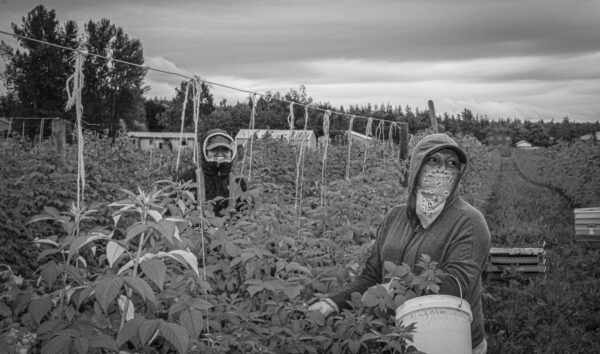
“It seems like a return to indentured servitude,” Rev. Richard Witt, executive director of the Rural and Migrant Ministry [RMM] in New York State told me after the US Supreme Court’s June 23, decision in Cedar Point Nursery v. Hassid.
In that case, the majority of conservative judges equated union organizers visiting farmworkers at their place of work with the “taking” of employers’ farms.
“What about [farmworkers’] property rights? Rev. Witt says. “If they’re living on the farm, don’t their property rights count?
The RMM is a non-profit interfaith organization advocating for the working poor and disenfranchised in the Empire State since the 1970s. Already, Rev. Witt says the RMM is encountering new “No Trespassing” signs popping all over New York.
“[Employers] can control who can come and see [farmworkers]. Are we going back to an era where only those who own land get to have their voices heard?” He says.
Even at its most militant and anti-capitalist, the American Labor Movement has never been able to secure the same hard-fought rights and protections for farmworkers as it has for other workers.
In 1935, after persistent collective action from below forced FDR to get behind the National Labor Relations Act and collective bargaining rights for workers — the bosses, albeit a little bruised, still held more than enough sway to force the exclusion of farmworkers from the pact.
The exclusions — fueled by Jim Crow racism and the demand for a permanent underclass of cheap labor — have continued to this day, subjecting essential farmworkers to universal abuse — including, but not limited to, violent attacks, sexual assault and an entrenched sub-minimum wage.
According to labor activists in New York, COVID-19 has infected more than 13,000 farmworkers nationwide — conservatively killing at least 43 of them. The real cost is unknown, however, because our governments pay so little attention to the essential workers who harvest the food we eat.
But the widespread acclaim that essential workers have finally achieved during the ongoing coronavirus pandemic has done little to remedy this enduring American evil. Unsurprisingly, Farmworkers, were among the majority of American workers left out of enforceable COVID-19 safety measures also announced in June.
It took California farmworkers, under the leadership of celebrated labor activist Cesar Chavez and the United Farmworkers Union [UFW], 40 years to win collective bargaining rights for themselves — and even then the victory was limited to the Golden State.
The Supreme Court’s June 23, ruling in the the Cedar Point Nursery v. Hassid erases those gains and could mean that, in addition to union organizers, farmworkers could now be cut off from other essential allies and supporters like Rev. Witt and the RMM — not to mention investigatory agents of the U.S federal government.
Edgar Franks is political director of Familias Unidas for la Justicia, an independent farmworker union representing workers from indigenous families across Washington State.
“We definitely think this is an anti-worker ruling,” Franks recently told me. “But it also goes beyond that. Chief Justice [John] Roberts redefined the 5th Amendment ‘taking clause.’ What if there were a health and safety violation? Would that mean they would be denied entrance to check on worker safety? This makes life harder for many workers.”
AFL-CIO President Richard Trumka also took issue with the SCOTUS’ view that farmworkers’ fundamental right to organize at the location where they work constitutes an unconstitutional “taking of their employers’ property.
“As the state of California recognized more than 45 years ago, meeting with the union during off-hours at their workplace is the only practical way for workers to organize when they must regularly move from farm to farm throughout the growing season,” Trumka said in a statement.
Indeed, Bruce Goldstein, president of Farmworker Justice, a national advocacy organization for farmworkers based in Washington, D.C., believes the SCOTUS’ June 23, decision is written so broadly it practically invites employers to test its limits.
“The court says it’s not much of an issue — but given the breath of their opinion, it’s difficult to understand what the limits are on the power of the employer to limit anyone coming onto their property,” he says.
Suzanne Adely is co-director of the Food Chain Workers Alliance [FCWA] — a coalition of 31 worker-based organizations advocating for more than 3750,000 food workers in the U.S. and Canada. She fears that the SCOTUS has already set a corrosive precedent.
“[Employers] say they are not going to that extent — but that won’t matter much if conservatives in the future try to utilize this ruling for their case. It’s utterly anti-union and anti-democratic. Globally speaking, a lot of countries around the world would consider this to be shocking.”
Three days after the Supreme Court ruling allowing growers to restrict access to farmworkers, temperatures soared to 104 degrees in St. Paul Oregon, killing a farmworker from Guatemala who was part of a crew moving irrigation lines for Ernst Nursery and Farms.
The man’s death spurred the Oregon Occupational Safety and Health division to open up investigations into both the Ernst Nursery and Farms and Brother Farm Labor Contractor — the agency providing workers for the grower.
“Simple, common-sense measures — rest, shade and water — can reduce the risk of heat-related illness and fatalities,” Jessica E. Martinez, co-executive director of National COSH said in response to the fatality. “Tragically, not all employers provide these necessities, which is why state and federal governments must act right away.”
Farmworker advocates, however, fear the Cedar Point Nursery v. Hassid ruling restricting access to farmworkers in the workplace could provide cover for growers who care little about the health and safety of those they employ.
“Even before this decision [meeting with farmworkers] was a difficult thing to do because of the long hours they work and the isolation of the farms. And also because of the intimidation that employers have been engaged in,” Adely told me. “This [ruling] could potentially extend the argument to curb health and safety inspectors.”
Goldstien, further points out that the potential for antebellum-level abuse of farmworkers is even greater for those actually living on farms as part of the H-2A Visa Program for Temporary Workers.
“State landlord/tenant laws give farmworkers the right to invite people and meet with them,” Goldstein says. “But this [ruling] does raise questions about whether courts would start to try to cut back on that access.”
Last year, the Department of Labor approved some 275,000 H2A positions. At least 205,000 guest workers came into the country to work jobs that pay between $12 and $16 an hour.
“Employers already have a lot of control [over farmworkers],” Goldstein adds. “You don’t want to be seen talking to a labor organizer. This decision raises the question of whether an employer can have even more control. Any employer or group of employers could decide if they want to test the limits. It also raises huge questions about restricting government staff and wage and hour investigations.”
Like other sectors of the economy, wage theft is rampant in the agricultural industry. During the first two decades of the new millennium, growers swindled $65 million from tens of thousands of farmworkers nationwide.
The DOL, however, steadfastly denies that Cedar Point Nursery v. Hassid will have any impact on its ability to investigate farmworker claims of wage theft.
“The Wage and Hour Division [WHD] remains committed to ensuring that our nation’s essential workers, like those in the agricultural industries, are afforded the essential protections federal labor laws provide,” a DOL spokesperson told me via email. “WHD will continue to fulfill its responsibility to investigate compliance with crucial labor protections in workplaces around the country, including investigating agricultural employers as appropriate.”
According to the WHD, the agency is focusing its enforcement priorities and resources on those industries where data and evidence shows violation rates are high and where investigators have found low-wage workers are reluctant to assert their rights.
“Agriculture is one of those industries,” the DOL spokesperson I contacted said, adding “WHD enforces the law for workers regardless of immigration status.”
But as already pointed out, institutionalized racism has always been at the core of farmworker abuse in the U.S. In 1938, the Fair Labor Standards Act purposely excluded Black farmworkers from new overtime protections. Today, only farmworkers in New York, California, Hawaii, Maryland, Minnesota and Washington are eligible for overtime pay.
Washington Governor Jay Inslee’s only signed legislation extending overtime protections to farmworkers this past May. The provisions won’t go into effect until next year. In some other “trailblazing” states, farmworkers — the overwhelming majority of them Hispanic — still have to labor 60 hours before seeing any overtime pay.
In Washington State, farmworkers spend 10- to 11-hours-a-day handpicking strawberries from mid-June to mid-July before switching over to blueberries and blackberries in late September. Last year, the US Dept. of Agriculture put the production value of one type of blueberry grown in Washington State at $217,467,000.
Franks characterizes the SCOTUS’ June 23, ruling as a continuation of the racism that underscored the exclusion of Black workers in the Fair Labor Standards Act of 1938, and says it’s “almost an attack on people of color trying to organize.”
“A lot of attention has been put on the reason farmworkers were left out,” he says. “A lot of it has to do with race — that plays a big part in why farmworkers don’t have protections that other workers have.”
Rev. Witt says he and the rest of the RMM staff are still trying to come to come to grips with what the US Supreme Court has just ruled.
“It’s always a real effort to help the government and consumers to remember and give thanks to farmworkers because they are so out of sight,” he says. “It’s this constant issue of getting our society not just to be thankful [to farmworkers] — but to institute policies and structures that respect their dignity.”



